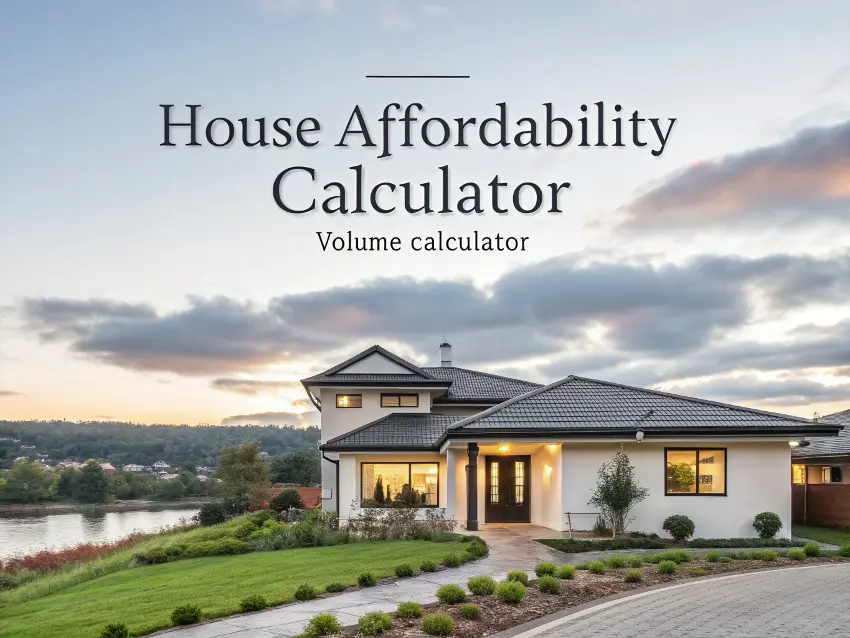House Affordability Calculator
Estimate how much house you can afford based on your income and financial situation

Income & Expenses
$
Enter your total gross annual income before taxes
$
Include bonuses, rental income, etc.
$
Include car loans, student loans, credit cards, etc.
Mortgage Details
$
%
%
%
$
$
Ratio of housing payment to income / total debt payment to income
Home Affordability Results
Based on your income and financial details
How much home can you afford?
You can afford a $0.00 home
Affordability Breakdown
- Max Loan Amount
- $0.00
- Down Payment
- $60,000.00 (20.0%)
- Monthly Principal & Interest
- $0.00
- Monthly Property Tax
- $0.00
- Monthly Insurance
- $0.00
- Monthly HOA Fees
- $0.00
- Total Monthly Housing Payment
- $0.00
- Front-End Ratio
- 0.00%%
- Back-End Ratio
- 0.00%%
Price Range Options
Conservative: $0.00
Moderate: $0.00
Aggressive: $0.00
Understanding Affordability
Front-End Ratio: The percentage of your monthly income that goes toward housing expenses.
Back-End Ratio: The percentage of your monthly income that goes toward all debt payments, including housing.
Conservative: Follows traditional lending guidelines with front-end ratio of 28% and back-end ratio of 36%.
Moderate: Uses slightly higher debt ratios that many lenders may still approve.
Aggressive: Approaches the maximum debt ratios some lenders will allow, but leaves little room in your budget.
Remember that affordability is not just about what lenders will approve - it's about what's comfortable for your budget and lifestyle.
Understanding Home Affordability: Beyond the Calculator
While our calculator provides a solid estimate of what you can afford, home buying involves many other financial considerations. Understanding the complete picture can help you make a more informed decision and avoid potential financial strain.
The 28/36 Rule: A Financial Guideline
Financial advisors often recommend the 28/36 rule as a guideline for housing affordability:
- 28% Rule: Your monthly mortgage payment (including principal, interest, taxes, and insurance) should not exceed 28% of your gross monthly income.
- 36% Rule: Your total monthly debt payments (including your mortgage and all other debt like car loans, student loans, and credit cards) should not exceed 36% of your gross monthly income.
For example, if your household earns $8,000 per month before taxes, your housing costs should ideally stay below $2,240 (28%), and your total debt payments (including housing) should not exceed $2,880 (36%).
Hidden Costs of Homeownership
Many first-time homebuyers focus only on the mortgage payment, overlooking these significant expenses:
Maintenance & Repairs
Budget 1-3% of your home's value annually for maintenance. Older homes generally require more maintenance than newer constructions.
Utilities
Electricity, water, gas, trash removal, internet, and possibly HOA fees can add hundreds of dollars to your monthly housing costs.
Property Insurance
Beyond standard homeowners insurance, you may need flood, earthquake, or other specialized insurance depending on your location.
Impact of Different Down Payments
| Down Payment | Benefits | Considerations |
|---|---|---|
| 3-5% (Minimum) |
|
|
| 10-15% (Moderate) |
|
|
| 20%+ (Traditional) |
|
|
Different Mortgage Types and Their Impact
The type of mortgage you choose significantly affects your affordability and financial flexibility:
Fixed-Rate Mortgages
Best for: Long-term homeowners who value payment stability
- Pros: Consistent payments, protection from rate increases
- Cons: Higher initial rates than ARMs, less flexibility
- Impact on affordability: May qualify for less house compared to adjustable rates, but provides long-term budget predictability
Adjustable-Rate Mortgages (ARMs)
Best for: Short-term homeowners or those expecting increasing income
- Pros: Lower initial rates, potentially more house initially
- Cons: Payment uncertainty after fixed period, potential for significant increases
- Impact on affordability: Can increase initial buying power but may create budget stress later if rates rise
Regional Considerations
Housing affordability varies dramatically by location. Consider these regional factors:
High-Cost Areas
- • Special loan programs like jumbo loans may be necessary
- • Property taxes and insurance typically much higher
- • Consider commute costs vs. premium for central locations
- • Look for high-cost area loan limits from FHA/Conventional loans
Rural/Lower-Cost Areas
- • USDA loans offer 0% down payment options
- • Property taxes often lower, but verify all local taxes
- • Budget for potentially higher transportation costs
- • Consider availability and cost of services (internet, utilities)